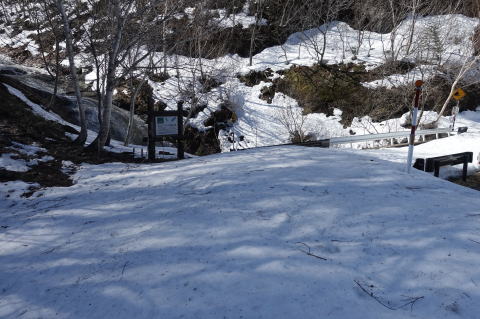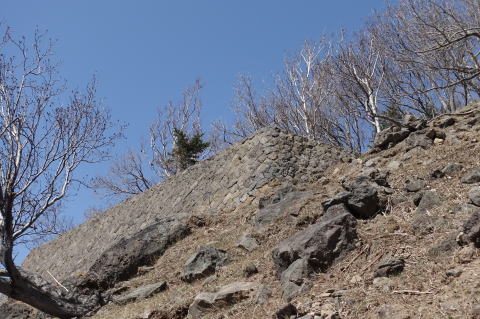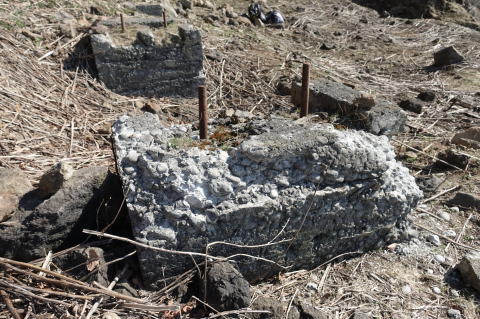Ten to six in the morning on April 20 the owner of my motel picked up and
took me to the gate at Shiretoko Five Lakes. I started walking along the
road to the Kamuiwakka Creek alone. The road should have been covered by
heavy snow but it has been removed. The distance from the gate to Kamuiwakka
Creek was 12 kilo meters it might have taken three hours to get there but
a car was about to pass me. The driver was a man who works for removing
the snow. He took me two kilo meters before the Kamuiwakka and I walked
farther in the heavy snow.
The Kamuiwakka Creek is a famous sightseeing atraction but when I arrived
there no other persons were there. The Kamuiwakka Bridge was berried with
heavy snow.
4月20日の6時10分前に民宿のご主人が来てくださって車で知床五湖のゲートまで送っていただいた。そこから一人でカムイワッカに向かって林道を歩き始めた。林道は本来雪で埋まっているはずなのだが、きれいに除雪されていた。カムイワッカの2km手前からは除雪がされていなくて、雪深い道を歩くのは結構難儀だった。
カムイワッカは有名な観光地だが、当然この時期誰もいない。カムイワッカ橋は雪で埋まっていた。

I just passed the Kamuiwakka Bridge and continued walking along the road.
I also passed the mountain trail entrance of Mt. Shiretokoiozan or Sulfur
Mountain and still went on along the road for 120 meters.
I walked out of the road and proceeded into the forest toward the sea shore.
There was an ancient mine trail. This area had been a sulfur mine and there
are some remains of mining facilities. I walked down the ancient mine trail
toward the sea shore.
There was a rock wall. It is a remains of aerial cableway station which
transfered sulfur ore from the mountain to the sea shore. However equipments
had been removed. This is the remains of aerial cableway 1.
カムイワッカ橋を過ぎてさらに林道を進み、硫黄山登山口も過ぎてさらに林道を120m進んだ。
そこで道路から海側の森の方へ入ると旧鉱山道が見つかる。このカムイワッカ周辺は、かつて硫黄鉱山だった。そのためところどころに今でも鉱山時代の施設跡を見ることができる。旧鉱山用の道を下って行くと石垣に到着する。それは索道という鉱山用のロープウェイの駅があったところで、鉱山時代、山で採取した硫黄を海岸沿いのこの場所に運んでいた。ただ、索道の設備はほとんど撤去されている。文献によると、これは第二索道と呼ばれるものだ。

Just beside the rock wall I climbed down the steep slope. Red 47 degree
Celsius hot spring is expelled. I walked down farther and there was a plane
land around 15 meters by 30 meters. I found some remains of concrete structures.
Those had been for the first cableway station. I guess the thick concrete
pulled the cables. During the mining days in 1936 to 1938, they transfered
the sulfur deposited at the Kamuiwakka Creek to the shore by this aerial
cableway.
石垣のそばを通って急な傾斜を降りていくと47℃の赤いお湯を出す温泉がある。そこからさらに下ると15m ×30m ほどの平らな土地があり、コンクリートの構造物が残されている。そこは第一索道の駅の遺構だ。1936-1938当時、カムイワッカに堆積した硫黄を索道(ロープウェイ)を使ってこの海岸まで運んでいた。
